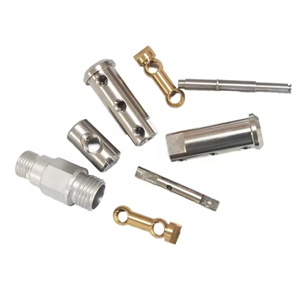Black Oxidation Treatment Of CNC Turned Components
The black oxidation treatment of CNC Turned Components is an important surface treatment technology, mainly used to improve the appearance of parts, enhance corrosion resistance and wear resistance. The following is a detailed explanation of the black oxidation treatment of CNC Turned Components, presented and summarized in clear points:
1、 Processing steps
Workpiece preparation:
Firstly, CNC Turned Components need to be thoroughly cleaned to remove surface oil, dirt, and impurities.
Use alkaline solution for degreasing and cleaning to ensure the surface of the parts is clean.
Pickling (if necessary):
If there is rust or oxide on the surface of CNC Turned Components, it needs to be removed by acid washing.
Pickling usually uses a sulfuric acid solution with a concentration of 10-15%. The pickling temperature is about 70-80 ℃, and the workpiece is immersed for about 30 minutes.
Oxidation treatment:
Oxidation treatment is a key step in forming a black oxide layer.
Immerse CNC Turned Components into a solution containing oxidants such as sodium hydroxide, nitrite, and nitrate.
Oxidation treatment can form a thick and uniform oxide film at high temperatures (such as over 100 ℃).
The time of oxidation treatment depends on the material and size of the parts, but it is usually a relatively long process.
Cleaning:
After the oxidation treatment is completed, CNC Turned Components need to be thoroughly cleaned with clean water to remove residual oxidants and impurities.
Post processing:
To enhance the rust and corrosion resistance of CNC Turned Components, post-treatment such as oil, wax, or paint can be applied to the oxide layer.
These post-processing steps not only enhance the waterproofing of CNC Turned Components, but also facilitate cleaning as they can block harmful substances from coming into contact with the metal inner layer.
2、 Processing principle
Black oxidation treatment is a chemical reaction between iron elements in metals and oxygen elements in oxidant solutions, forming a dense black oxide film (mainly iron trioxide, Fe3O4).
This oxide film can isolate air and water, preventing oxidation and corrosion inside the metal.
3、 Type
Hot black oxidation:
At higher temperatures (such as 130-145 ℃), oxidation treatment results in a thick and uniform oxide film.
Suitable for parts with high requirements for rust prevention and corrosion resistance.
Medium temperature black oxidation:
Perform oxidation treatment at lower temperatures (90-120 ℃).
It can effectively reduce the generation of corrosive gases and is suitable for scenarios with high environmental requirements.
4、 Application
The black oxidation treatment of CNC Turned Components is widely used in various fields such as mechanical equipment, aerospace, electronics, medical devices, etc.
The parts treated with black oxidation not only have a beautiful appearance, but also have excellent corrosion resistance and wear resistance, which can significantly extend their service life.
5、 Advantages
Improving wear resistance: Oxidized black treatment can form a ceramic like oxide layer on the surface of CNC Turned Components, which has strong hardness and wear resistance, preventing the metal surface from being worn and scratched.
Enhanced corrosion resistance: Oxidized black treatment can form a dense oxide layer, effectively isolating the surface of CNC Turned Components from contact with the external environment, and preventing corrosion of the metal surface.
Improving surface lubricity: Oxidized black treatment can form a layer of microporous oxide on the surface of CNC Turned Components, which can adsorb lubricating oil and improve the lubrication performance of the metal surface.
Beautifying the appearance: Oxidized black treatment can make the surface of CNC Turned Components appear black or dark gray, with a certain decorative effect, improving the product’s aesthetics and added value.
